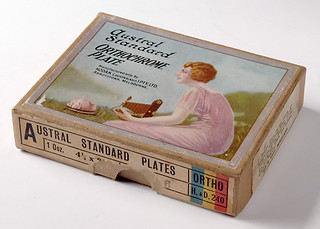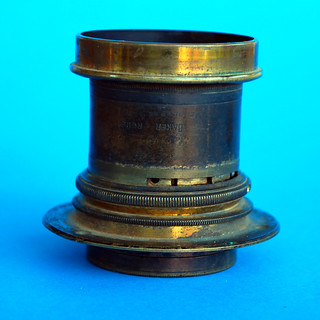Baker and Rouse
Baker and Rouse was a maker of photographic materials in Melbourne, Australia, from the late 19th century well into the 20th. Thomas Baker started the company as the Austral Plate Company in 1884. He formed a partnership with John Rouse in 1887; the company was renamed Thomas Baker and Company Laboratory, then Baker and Rouse Australia Laboratory, and finally in 1896 Baker and Rouse Pty Ltd.[1] In the 1890s the company had stores in Melbourne and Adelaide[2] and later also in Sydney and Brisbane.[3] In April 1905 Baker & Rouse took over the sole agency for Kodak materials in Australia.[4] Baker and Rouse merged with Eastman Kodak in 1908, both men remaining as directors of Kodak (Australasia) Pty. Ltd.

|
| Austral Plates (made by Kodak Australasia) image by Geoff Harrisson (Image rights) |

|
| Baker & Rouse 6 x 5 Rapid Symmetrical image by Dirk HR Spennemann (Image rights) |
Cameras
Austral falling-plate detective cameras have been seen in several sizes (No. 1A, No. 3 and No. 3A are listed at various websites)
Lenses
Baker & Rouse imported lenses from European manufacturers, including French.[5]
- 6 x 5 Rapid Symmetrical [6]
French Origin
- Wide Angle Rectilinear 4 ¼ X 3 ¼ [7]
Notes
- ↑ Introductory page to the Baker & Rouse collection at Museum Victoria.
- ↑ See inscription on this 6 x 5 Rapid Symmetrical.
- ↑ See inscription on this Wide Angle Rectilinear 4 ¼ X 3 ¼.
- ↑ "Australians Behind the Camera" Sandy Barrie p.11.
- ↑ See inscription on this Wide Angle Rectilinear 4 ¼ X 3 ¼.
- ↑ See this lens.
- ↑ See inscription on this lens.
Links
- Austral No. 3A falling-plate camera marked for Baker & Rouse Pty Ltd, presumably dating it to 1908 or earlier, in sespquiped's Flickr photostream.
- Cameras including an Austral No. 3 at Aussiebloke
- Wide Angle Rectilinear 4 ¼ X 3 ¼ images with Nikon D800 (Antique Camera Simulator)
- US Patent 1269365, Photographic Roll-Film Cartridge, filed December 1916 and granted June 1918 to Thomas Baker of Eastman Kodak, at Espacenet, the patent search facility of the European Patent Office. The patent describes an improvement to a roll-film cartridge (described as an Autographic one, though this detail does not matter). As in a modern 120 roll, the leading end of the film is attached to the backing paper by a gummed sticker or tape. The trailing end is not fixed, because it must be allowed to 'creep' slightly relative to the backing during rolling. However, it was normal for the trailing end to be fixed to the paper for development, and a gummed sticker was provided for this. The sticker was attached to the film, and the patent states that the moisture used to wet the gum could migrate, causing the sticker to adhere to the backing paper prematurely. Baker's patent solves this simply by making the sticker long, with an ungummed section in the middle.